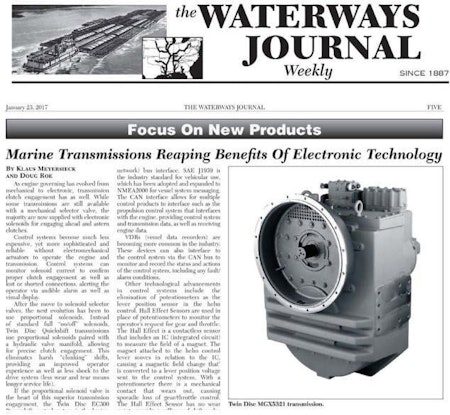
Twin Disc is featured in January issue of The Waterways Journal: Focus on New Products
In a recent January issue of, The Waterways Journal Weekly, Twin Disc was featured writing a State of the Industry article for the Marine Market. The article was a concise summation focused on marine propulsion and how it had advanced over the years leading to where the Twin Disc product family is today. It was written by Twin Disc Product Managers, Doug Roe and Klaus Meyersieck who together look over the full line of development on Twin Disc’s marine transmissions and electronic controls.
The article discusses in detail the drive for new product development in the marine industry over the last 20 years, including a full line of electronic controls and enhanced clutch performance, all the way to the new embedded smart chips soon to be found in all Twin Disc manufactured transmissions. The article also highlights many relevant issues including digital messaging to the industry standard of NMEA2000 for vessel system messaging.
All and all, I wanted to make sure I shared this article with our customer base to keep you informed on how Twin Disc is staying more than relevant but is leading still leading the charge in this highly regulated industry. My team works very closely with Twin Disc to be sure we are considering everything when helping our customers with their propulsion needs. I hope you find the article interesting please let me know if there are any areas where you would like clarification or more detail.

Marine Transmissions and Control Systems-Twin Disc Inc. “More than just a Clutch”
As engine governing has evolved from mechanical to electronic, transmission clutch engagement has as well. While some transmissions are still available with a mechanical selector valve, the majority are now supplied with electronic solenoids for engaging ahead and astern clutches.
Control systems become much less expensive, yet more sophisticated and reliable without electromechanical actuators to operate the engine and transmission. Control systems can monitor solenoid current to confirm proper clutch engagement as well as lost or shorted connections, alerting the operator via audible alarm as well as visual display.
After the move to solenoid selector valves, the next evolution has been to use proportional solenoids. Instead of standard full “on/off” solenoids, Twin Disc Quickshift® transmissions use proportional solenoids paired with a hydraulic valve manifold, allowing for precise clutch engagement. This eliminates harsh “clunking” shifts, providing an improved operator experience as well as less shock to the drive system (less wear and tear means longer service life).
If the proportional solenoid valve is the heart of this superior transmission engagement, the Twin Disc EC300 PowerCommander® control system is the brains. If not done correctly, proportionally engaging a transmission clutch can cause clutch plate damage. The control system uses accurate engagement profiles and closed-loop monitoring to ensure the clutch is properly protected.
This precise control over clutch engagement eliminates the need for old-fashioned external trolling valves. Quickshift® transmissions precisely controlled by the EC300 can provide a repeatable, wide range of slow shaft speeds ranging from 10% to 90% of full-engagement speed at engine idle. Slow yet responsive shaft speed and direction allows for easier docking or maneuvering to a tow.
In addition to keeping up with evolving engine and transmission technology, control systems now incorporate digital messaging via a CAN (computer area network) bus interface. SAE J1939 is the industry standard for vehicular use, which has been adopted and expanded to NMEA2000 for vessel system messaging. The CAN interface allows for multiple control products to interface such as the propulsion control system that interfaces with the engine, providing control system and transmission data, as well as receiving engine data.
VDRs (vessel data recorders) are becoming more common in the industry. These devices can also interface to the control system via the CAN bus to monitor and record the status and actions of the control system, including any fault/alarm conditions.
Other technological advancements in control systems include the elimination of potentiometers as the lever position sensor in the helm control. Hall Effect Sensors are used in place of potentiometers to monitor the operators request for gear and throttle. The Hall Effect is a contactless sensor that includes an IC (integrated circuit) to measure the field of a magnet. The magnet attached to the helm control lever moves in relation to the IC, causing a magnetic field change that` is converted to a lever position voltage sent to the control system. With a potentiometer there is a mechanical contact that wears out, causing sporadic loss of gear/throttle control. The Hall Effect Sensor has no wear point; providing millions of shift cycles without loss of command.
Other advances in transmission and control technology are due to come in time. In the near future, Twin Disc transmissions will have embedded smart chips. Smart Chips are small memory devices that store data such as transmission part number, serial number, ratio, warranty dates, shift cycles and more.
Many look at their marine transmission as a simple clutch to engage their prop-shaft, but over the years it has evolved into much more than just a clutch. Ongoing improvements in transmission and control technology will continue to make for enhanced boating operations.
Keep Reading




